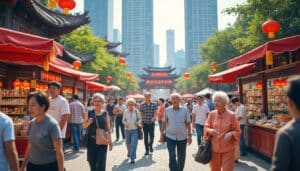Welcome to our digital space dedicated to your experience. Every interaction you have enriches the services we offer. Understanding the use of cookies is essential for informed browsing.
We use cookies and data to provide and maintain services like those from Google. This allows us to track interruptions and protect against abuses such as spam and fraud. By measuring audience engagement and site statistics, we gain better insights into the use of our services and improve their quality. If you choose “Accept all”, we will also use data to develop new services, measure the effectiveness of ads, and display personalized content based on your settings. On the other hand, by choosing “Reject all”, we will not use cookies for these additional purposes. Non-personalized content depends on your current search activity, your location, and the content you are viewing. To manage your privacy settings, select “More options” or visit g.co/privacytools at any time.

With the rapid aging of its population, China finds itself at a crucial economic crossroads. The rise of the silver economy offers a multitude of opportunities for various sectors, thereby stimulating dynamic and sustained growth. This demographic evolution is not only a challenge but also a chance to reinvent and adapt various economic fields to meet the needs of an aging population.
What are the main drivers of the silver economy in China?
The silver economy in China is primarily driven by several key factors. First, the increase in life expectancy and the decrease in birth rates have led to a growing proportion of elderly individuals in the population. This demographic trend creates an increased demand for specialized services such as healthcare, senior residences, and products tailored to this age group. At the same time, the purchasing power of seniors in China continues to grow, allowing for increased consumption across various sectors.
Furthermore, technological innovation plays a crucial role in the development of the silver economy. Advances in health technologies, connected devices, and telemedicine solutions facilitate the improvement of quality of life for the elderly. For example, Click Holdings Limited innovates in the senior care sector by using cryptographic technologies to energize the economy, perfectly illustrating the intersection between technology and senior needs.
Which sectors benefit the most from the silver economy in China?
The silver economy positively influences several sectors in China, each leveraging the specific needs of elderly individuals. Among the most impacted sectors are:
Healthcare
The healthcare sector is experiencing exponential growth due to the increasing demand for specialized medical services for seniors. Healthcare establishments are investing in modern infrastructure and advanced technologies to provide better quality care. Moreover, senior care platforms, like those mentioned in Senior care platforms optimistic about their growth, optimize the services offered by using innovative business models.
Real Estate
With an aging population, the real estate sector is adapting by offering housing suitable for the needs of elderly individuals. Real estate projects now include specific adaptations such as ramps, accessible elevators, and community living spaces. In addition, initiatives like Redefining mortgages with customized real estate loans allow seniors to better manage their finances for purchasing suitable housing.
Technology and Innovation
Technological development is another major benefiting sector of the silver economy. Companies are investing in technological solutions designed to enhance the lives of seniors, such as health monitoring devices, simplified communication applications, and smart home services. These innovations allow for greater autonomy for elderly individuals while ensuring better management of their health and well-being.
How does the silver economy influence consumption and the market?
The silver economy has a significant impact on consumption habits and the market overall. Seniors represent a substantial share of the consumer market, with specific preferences that influence the offerings of businesses. For example, the market for senior-friendly toys stimulates the expansion of the silver economy in China by offering products that meet the mobility and cognitive stimulation needs of elderly individuals, as highlighted by Senior-friendly toys stimulate expansion.
Moreover, financial services are evolving to better meet the needs of seniors, with investment and insurance products tailored to their economic situation and retirement outlook. Companies are also developing targeted marketing strategies specifically aimed at this demographic, enhancing the relevance and effectiveness of advertising campaigns.
What are the challenges associated with the silver economy in China?
Despite the many opportunities, the silver economy in China faces several challenges. One of the main obstacles is the need to rapidly adapt infrastructure and services to meet the growing needs of seniors. This includes not only investments in the healthcare sector but also in transportation, housing, and information technology.
Another major challenge is training and retaining qualified professionals in the elderly care sector. The demand for skilled personnel often exceeds the supply, which can lead to uneven service quality. Additionally, it is crucial to promote a culture of inclusion and respect towards seniors to combat stereotypes and improve their quality of life.
Finally, managing the personal finances of seniors presents another challenge, requiring innovative solutions to offer secure and suitable financial products. Initiatives like Redefining mortgages are essential to help seniors navigate this complex economic landscape.
What are the future prospects for the silver economy in China?
The future prospects for the silver economy in China are promising, with numerous opportunities for growth and innovation. As the population continues to age, the demand for suitable services and products will only increase, thereby supporting several economic sectors. Technological innovation, in particular, will play a key role in improving the quality of life for seniors and creating new business opportunities.
Governments and private companies are working together to develop policies and strategies that support the silver economy. For example, the inauguration of the 10th Golden Age Exhibition underscores the importance of the silver economy and highlights its potential.
Furthermore, increased awareness and educational initiatives will contribute to a better understanding and response to the needs of seniors, thereby fostering a more inclusive and resilient society. The silver economy is not only a driver of economic growth but also a vector of social and technological progress, paving the way for a new era of sustainable and equitable development.









